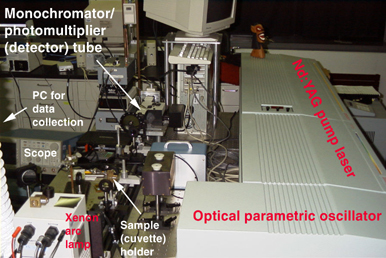Elizabeth R. Gaillard
Light Damage in Biological Tissues
The general topic of interest in our research group is the study of the mechanisms involved in photooxidative damage to biological systems, particularly in the human eye. Photooxidative damage is implicated in a number of ocular disorders such as age-related cataract formation and age-related macular degeneration (AMD), the leading cause of blindness in older adults. Light damage to biological systems may not manifest itself on a macroscopic level for decades, but the damage is initiated by short-lived, electronically excited species that participate in Type I or Type II oxidative chemistry. We use a wide variety of experimental methods to study these systems, including laser-based time-resolved spectroscopy. By determining the sequence of events that leads to tissue injury and identifying the reactive species along the reaction pathway, we may be able to develop methods to slow down or stop these processes.

Currently, we are pursuing three major projects:
- In collaboration with several other research groups, we have developed new methods for accurately measuring the absorption/transmission properties of the individual ocular components, as well as the collective spectra of the anterior segment of the eye. These studies are important because they allow us to define exactly what portion and what intensity of the ambient spectrum is transmitted to each structure.
- Several retinal disorders, most notably AMD, are associated with the accumulation of lipofuscin, a mixture of pigments, in the retinal pigment epithelium. Lipofuscin absorbs visible light that is transmitted to the retina; it has also been observed to sensitize singlet oxygen in vitro. We are investigating the photochemistry of several components of lipofuscin to determine their potential role in enhancing oxidative stress in the retina. These studies also have potential applications to non-invasive diagnostic methods.
- One age-related change that occurs in the human lens is the gradual yellowing of the lens proteins. The lens consists of a highly concentrated protein solution, as well as several chromophores of low molecular weight that absorb light transmitted through the cornea. We are developing model systems for the yellowed lens proteins by photochemically attaching the native chromophores to lens protein and then comparing their photochemical properties to those of isolated human lens proteins.
Representative Publications
- Brash, D. E., and Gaillard, E. R. "Quantum biology: Chemiexcitation in preventing macular degeneration." Frontiers in Photonics, 2024. doi: 10.3389/fphot.2024.1451857.
- Seethi, V. D. R., LaCasse, Z., Chivte, P., Gaillard, E. R., Bland, J., Kadkol, S., Bharti, P., and Alhoori, H. "An explainable-AI approach for diagnosis of COVID-19 using MALDI-ToF mass spectrometry." Expert Systems with Applications, 2024, 236, 121226. Available online Sept. 2023. doi: 10.1016/j.eswa.2023.121226.
- LaCasse, Z., Chivte, P., Seethi, V. D. R., Bland, J., Kadkol, S., Alhoori, H., and Gaillard, E. R. "Amylase depletion significantly improves the sensitivity and specificity of MALDI-ToF protein profiling for COVID-19 diagnostics." Journal of Mass Spectrometry and Advances in the Clinical Lab, 2024, 31, 59–71. doi: 10.1016/j.jmsacl.2024.01.003.
- Chivte, P., LaCasse, Z., Seethi, V. D. R., Bharti, P., and Gaillard, E. R. "MALDI-ToF protein profiling as a potential rapid diagnostic platform for COVID-19." Journal of Mass Spectrometry and Advances in the Clinical Lab, 2021, 21, 31–41. doi: 10.1016/j.jmsacl.2021.09.001.
- Vega, M., Lal, J., Lurio, L., and Gaillard, E. R. "Structure of supported DPPC-cholesterol bilayers studied via X-ray reflectivity." Physical Chemistry Chemical Physics, 2020, 22, 19089–19099.
- Yacout, S. M., McIlwain, K., Mirza, S. P., and Gaillard, E. R. "Characterization of RPE melanin and degraded synthetic melanin using mass spectrometry and in vitro biochemical diagnostics." Photochemistry and Photobiology, 2018. doi: 10.1111/php.12934.
- Brash, D. E., Bechara, E. J. H., and the Excited-State Medicine Working Group (E. R. Gaillard, working group member). "A glimpse of quantum medicine: Chemical excitation of electrons in disease." Trends in Molecular Medicine, 2018, 24, 527–541.
- Thao, M. T., Karumanchi, D. K., Yacout, S. M., and Gaillard, E. R. "Non-enzymatic nitration of glycoproteins from human Bruch's membrane: A model system for inflammation." Nitric Oxide, 2018. doi: 10.1016/j.niox.2018.07.006.
- Karumanchi, D. K., Skrypai, Y., Thomas, A., and Gaillard, E. R. "Rational design of liposomes for sustained release drug delivery of bevacizumab to treat ocular angiogenesis." Journal of Drug Delivery Science and Technology, 2018, 47, 275–282. doi: 10.1016/j.jddst.2018.07.003.
- Yacout, S. M., Elsawa, S. F., and Gaillard, E. R. "Calf melanin immunomodulates RPE cell attachment to extracellular matrix protein." Graefe's Archive for Clinical and Experimental Ophthalmology, 2018, 256(10), 1883–1893.
- Burgess, E. R. IV, Watkins, S. M., Tournear, J. C., Chantos-Davidson, K., Kremer, A., Morrow, J., Hagen, T., Gaillard, E. R., and King, B. H. "Dissemination of imidacloprid through dairy manure and its effect on the biological control agent, Spalangia endius (Hymenoptera: Pteromalidae), and a filth fly host, Musca domestica (Diptera: Muscidae)." Journal of Economic Entomology, 2018. doi: 10.1093/jee/toy386.
- Vodnala, P., Karunaratne, N., Lurio, L., Thurston, G., Vega, M., Gaillard, E. R., Narayanan, S., Sandy, A., Zhang, Q., Dufresne, E. M., Foffi, G., Grybos, P., Kmon, P., Maj, P., and Szczgiel, R. "Hard-sphere-like dynamics in highly concentrated alpha-crystallin suspensions." Physical Review E, 2018. doi: 10.1103/PhysRevE.97.0206021.
- Yacout, S. M., and Gaillard, E. R. "The anthocyanins, oenin and callistephin, protect RPE cells against oxidative stress." Photochemistry and Photobiology, 2017, 93, 590–599.

Professor
La Tourette Hall 322
815‐753‐6908
gaillard@niu.edu
Educational Background
Research Fellow, Center for Photoinduced Charge Transfer, 1995–1996
Research Fellow, Center for Fast Kinetics Research, 1992–1994
Visiting Assistant Professor, Southwest Texas State University, 1991–1992
Ph.D., University of Texas at Austin, 1991
B.S., Florida State University, 1984
Research Interests
Photochemistry, chemical kinetics, time‐resolved spectroscopy, photooxidative damage to biological tissue.